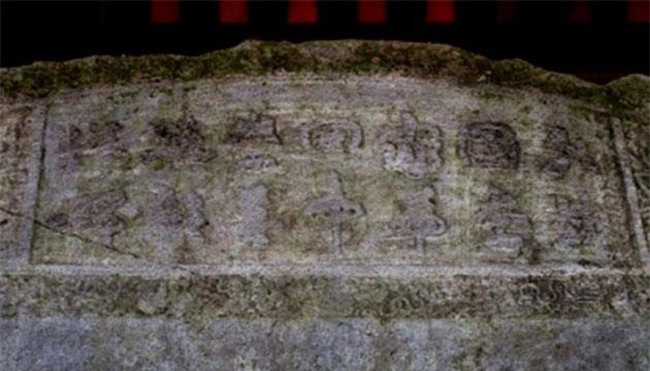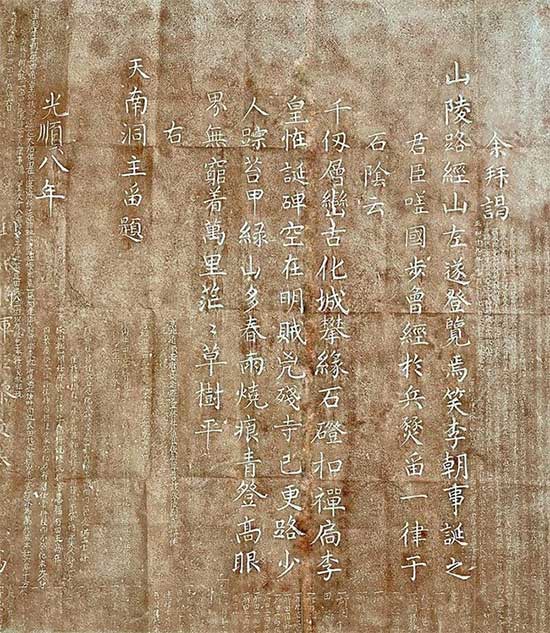The Ly Dynasty (1009 – 1225) was a period marked by significant achievements in civilization in Vietnamese history. One of the important legacies that remain to this day is the Stela of Sung Thien Dien Linh, located at Long Doi Son Pagoda in Duy Tien District, Ha Nam Province.
This stela preserves the inscriptions of two of the most illustrious kings in our history.
Unique Carving Art
The Stela of Sung Thien Dien Linh – formally titled “Stela of the Sung Thien Dien Linh Pagoda of the Fourth King of the Ly Dynasty, Great Viet Nation”, was erected in 1121 at Long Doi Son Pagoda, now in Duy Tien District, Ha Nam Province.
According to information archived at the Department of Cultural Heritage, the stela is made of a solid green stone weighing about one ton, standing 1.75 meters tall. The front face of the stela is adorned with a symmetrical dragon motif on either side. The dragon has its head raised high, with a body that coils gracefully, tapering gently towards the tail. Surrounding it are flame-shaped clouds intertwined around the dragon’s feet.
On the back of the large dragon, there is a smaller coiling dragon positioned across the four curves of the larger dragon, creating a pair of “mother and child” dragons.
The back face of the stela is decorated somewhat differently from the front, featuring a leaf design at the center. The heads of the dragons on either side of the stela are positioned as if reaching upwards towards the front face. The sides of the stela are decorated with consecutive diamond-shaped patterns, with a pair of dragons carved between them.

The front face of the Stela of Sung Thien Dien Linh with the inscription of King Ly Nhan Tong carved on it (photo taken at the exhibition reconstructing the architecture of One Pillar Pagoda during the Ly Dynasty). (Photo: Kien Thuc)
The entire stela is placed on an oval-shaped pedestal that is 50 cm high, 2.4 m long, and 1.8 m wide. In the center, there is a niche to hold the stela.
Each side of the pedestal features relief carvings of two dragons. The dragon bodies twist into five segments, with their heads facing each other and pointing upwards towards the stela. The dragon bodies are symmetrically coiled. Their tails intertwine, tapering into a “twisted rope” shape.

Close-up of the stela’s face with the Phi Bach inscription of King Ly Nhan Tong. (Photo: Nhan Dan Newspaper)
On the right side of the stela is a poem along with an introduction by King Le Thanh Tong composed in the 8th year of the Quang Thuan era (1467) during his visit to the pagoda, written by his minister, General Le Van, upon command.
The poem is titled “Climbing Long Doi Mountain to Write on the Stela of Sung Thien Dien Linh” (Ascending Long Doi Mountain to write after the Stela of Sung Thien Dien Linh), starting with the introduction: I went to pay homage to the mountain shrine, taking the left path of this mountain, and then visited the pagoda. I laughed at the kings and ministers of the Ly Dynasty who revered the void, lamenting the country that has endured many wars. Thus, I leave a poem on the back of the stela:
Heavenly acceptance, the ancient dragon at Hoa Thanh
(On the high range at the ancient Hoa Thanh)
Climbing the rocky pass, knocking on the temple door.
(Climbing the rocky pass, knocking on the temple door.)
The Ly kings’ voidness remains only on the stela
(The void of the Ly kings exists only on the stela)
The Minh bandits are brutal, they have already ravaged.
(The Minh bandits are brutal, the pagoda is not as it used to be.)
The road is sparse, the moss covers green
(The road is deserted, covered in green moss)
The mountains have much spring rain lacking silver sound.
(The mountains have much spring rain, the fire marks turn green.)
Climbing high, the view is boundless ahead
(Climbing high, the view widens)
Countless miles, the grass and trees are even.
(Endless miles, the grass and trees are flat.)

The poem of King Le Thanh Tong (photo of the rubbing)
Valuable Content and Extraordinary Destiny
The front of the stela features a text with a total of 4257 Chinese characters, containing three main ideas:
- Part One: Praising Buddha Shakyamuni and the profound and mystical teachings of Buddhism;
- Part Two: Praising King Ly Nhan Tong: From the auspicious signs at birth, his dignified appearance, his understanding and ingenuity in creating the golden turtle, his craftsmanship, his efforts in fostering prosperity, the construction of Buddhist pagodas, his divine power, and his concerns for a prosperous era under his reign. The stela also praises Grand Marshal Ly Thuong Kiet – the commander of the second resistance against the Song. Particularly, it provides rare information unique to this stela, such as the seven-day lantern festival in the capital Thang Long during the Ly Dynasty, water puppetry, esoteric rituals, the restoration of Dien Huu Pagoda (One Pillar Pagoda), and folk and court entertainment activities.
- Part Three: Narrating the process of constructing the Sung Thien Dien Linh Tower and the pagoda, and the great blessings of this merit.
At the end of the text is an inscription stating “the stela was erected on the 6th day of the 7th month of the Tan Suu year, the second year of the Thien Phu Duyet Vu era” (which corresponds to August 20, 1121).
It can be noted that on the front of the stela, the historical value of the text is no less significant than the handwriting of King Ly Nhan Tong. Especially, the second part of the text describes quite comprehensively the life of the Ly royal court, the achievements of historical figures, and the initial appearance of iconic architectural works such as the One Pillar Pagoda and the Imperial City of Thang Long…
If the text on the front is a page of Ly history, then the back of the stela resembles a chronicle recording many events. The back is carved into five sections with five different dates, featuring varying sizes of characters. Some sections of the text are faded and missing.
Corresponding to each era are the following contents:
Ly Era: The revered Holy Mother Linh Nhan (Y Lan) – the mother of King Ly Nhan Tong, donated 72 acres of land. The inscription was carved on the 6th day of the 7th month of the Tan Suu year, the second year of the Thien Phu Duyet Vu era (1121).
Le So Era: The poem by King Le Thanh Tong.
Mac Era: On the left side of the stela, carved during the Doan Duong festival on the 5th day of the 5th month of the Tan Mao year, the fourth year of the Hung Tri era, the fifth king of the Mac Dynasty (1591), recording the reconstruction of the fallen stela, repair of the roof beams, restoration of damaged statues, reconstruction of the gate, and building the back wall after more than five hundred years of deterioration.
Le Trung Hung Era: On the right side of the stela, inscribed on the 7th day of the 10th month of the 19th year of the Chinh Hoa era (Le Hy Tong 1698), recording the content of the agreement regarding the Tam Bao rice fields of Doi Son village.
The reason the back of the Stela of Sung Thien Dien Linh contains texts from four different eras is that in the early 15th century, Dai Viet was invaded by the Minh army. At Long Doi Son Mountain, the Minh forces destroyed the tower, and the stela was toppled. The poem by King Le Thanh Tong inscribed later recorded this event as well as the desolate state of the pagoda afterward.
By the fourth year of the Hung Tri era of the Mac Dynasty (1591), with the joint efforts of Duy Tan District Chief Cai Huyen, Commander Van Bang Ba, Deputy Chief Phu Trieu Ba, Phu Thang Ba, Chief Lam Kieu Ba, and the people of Doi Son, Doi Trung, Doi Linh, Trung Tin, the stela was restored to its original state.
In 1997, with support from the government, the pagoda, and local residents, a stela shelter was built to preserve this valuable heritage, which has been maintained as a place to keep the imprints of history.





















































